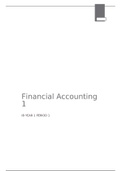Summary
Summary Financial Accounting 1
- Course
- Institution
- Book
This is a summary for financial accounting 1. It covers the chapters 1,2,3,4,5,12,14, and 15 of the book "Horngrens financial and managerial accounting: the financial chapters".
[Show more]




